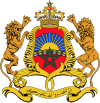Wattasid dynasty
This article needs additional citations for verification. (October 2012) |
Wattasid dynasty الوطاسيون | |||||||||
|---|---|---|---|---|---|---|---|---|---|
| 1472–1554 | |||||||||
 Map of the Wattasid sultanate (dark red) and its vassal states (light red) | |||||||||
| Status | Ruling dynasty of Morocco
| ||||||||
| Capital | Fez | ||||||||
| Common languages | Berber languages Arabic[3] | ||||||||
| Religion | Sunni Islam | ||||||||
| Government | Monarchy | ||||||||
| Sultan | |||||||||
• 1472-1504 | Abu Abd Allah al-Sheikh Muhammad ibn Yahya | ||||||||
• 1545-1547 | Nasir al-Qasri | ||||||||
| History | |||||||||
• Established | 1472 | ||||||||
| 1554 | |||||||||
| Currency | Dirham | ||||||||
| |||||||||
The Wattasid dynasty (
Overview
Morocco endured a prolonged multifaceted crisis in the 15th and early 16th centuries brought about by economic, political, social and cultural issues. Population growth remained stagnant and traditional commerce with the far south was cut off as the Portuguese occupied all seaports. At the same time, the towns were impoverished, and intellectual life was on the decline.
History
Morocco was in decline when the Berber Wattasids assumed power. The Wattasid family had been the autonomous governors of the eastern
The Wattasid rulers failed in their promise to protect Morocco from foreign incursions and the Portuguese increased their presence on Morocco's coast. Mohammad al-Chaykh's son attempted to capture Asilah and Tangier in 1508, 1511 and 1515, but without success.
In the south, a new dynasty arose, the Saadian dynasty, which seized Marrakesh in 1524 and made it their capital. By 1537 the Saadis were in the ascendent when they defeated the Portuguese Empire at Agadir. Their military successes contrast with the Wattasid policy of conciliation towards the Catholic kings to the north.
As a result, the people of Morocco tended to regard the Saadians as heroes, making it easier for them to retake the Portuguese strongholds on the coast, including Tangiers, Ceuta and Maziɣen. The Saadians also attacked the Wattasids who were forced to yield to the new power. In 1554, as Wattasid towns surrendered, the Wattasid sultan, Ali Abu Hassun, briefly retook Fez. The Saadis quickly settled the matter by killing him and, as the last Wattasids fled Morocco by ship, they too were murdered by pirates.
The Wattasid did little to improve general conditions in Morocco following the Reconquista. It was necessary to wait for the Saadians for order to be reestablished and the expansionist ambitions of the kingdoms of the Iberian peninsula to be curbed.
Coinage
Known Wattasid coins include a few extremely rare gold coins and also square silver dirhams and half dirhams, still following the Almohad Caliphate standard of roughly 1.5 grams.[5]
The dynasty
| History of Morocco |
|---|
 |
Wattasid Viziers
- 1420–1448: Abu Zakariya Yahya al-Wattasi
- 1448–1458: Ali ibn Yusuf
- 1458–1459: Yahya ibn Abi Zakariya Yahya
Wattasid Sultans
- 1472–1504: Abu Abd Allah al-Sheikh Muhammad ibn Yahya
- 1504–1526: Abu Abd Allah al-Burtuqali Muhammad ibn Muhammad
- 1526–1526: Abu al-Hasan Abu Hasan Ali ibn Muhammad
- 1526–1545: Abu al-Abbas Ahmad ibn Muhammad
- 1545–1547: Nasir ad-Din al-Qasri Muhammad ibn Ahmad
- 1547–1549: Abu al-Abbas Ahmad ibn Muhammad
- 1554–1554: Abu al-Hasan Abu Hasun Ali ibn Muhammad
Family tree
| Family tree of the Wattasid dynasty | |||||||||||||||||||||||||||||||||||||||||||||||||||||||||||||||||||||||||||||||||||||||||||||||||||||||||||||||||||||||||||||||||||||||||||||||||||||||||||||||||||||||||||||||||||||||||||||||||||||||||||||||||||||||||||||||||||||
|---|---|---|---|---|---|---|---|---|---|---|---|---|---|---|---|---|---|---|---|---|---|---|---|---|---|---|---|---|---|---|---|---|---|---|---|---|---|---|---|---|---|---|---|---|---|---|---|---|---|---|---|---|---|---|---|---|---|---|---|---|---|---|---|---|---|---|---|---|---|---|---|---|---|---|---|---|---|---|---|---|---|---|---|---|---|---|---|---|---|---|---|---|---|---|---|---|---|---|---|---|---|---|---|---|---|---|---|---|---|---|---|---|---|---|---|---|---|---|---|---|---|---|---|---|---|---|---|---|---|---|---|---|---|---|---|---|---|---|---|---|---|---|---|---|---|---|---|---|---|---|---|---|---|---|---|---|---|---|---|---|---|---|---|---|---|---|---|---|---|---|---|---|---|---|---|---|---|---|---|---|---|---|---|---|---|---|---|---|---|---|---|---|---|---|---|---|---|---|---|---|---|---|---|---|---|---|---|---|---|---|---|---|---|---|---|---|---|---|---|---|---|---|---|---|---|---|---|---|---|
| |||||||||||||||||||||||||||||||||||||||||||||||||||||||||||||||||||||||||||||||||||||||||||||||||||||||||||||||||||||||||||||||||||||||||||||||||||||||||||||||||||||||||||||||||||||||||||||||||||||||||||||||||||||||||||||||||||||
Chronology of events
- According to the Treaty of Alcáçovas (1479), and to the Treaty of Tordesillas (1494), Spain recognized the kingdom as being in the Portuguese sphere of influence.
- 1485: Treaty with Spain: The sultanate agrees to not help the Kingdom of Granada, Spain agreed to not capture Moroccan ships in the Alboran Sea.
- 1488: Portuguese conquer Safi.
- 1491: Muhammad XIII, Sultan of Granada(El Zagal) went to Fez, but was captured and blinded.
- 1492: Arrival of Spanish Muslims and Jews.
- 1497: Spain captures Melilla
- 1502: Portugal captures Mazagan.
- 1505: Portugal captures Agadir.
- 1506: Portugal captures Mogador.
- 1511: Saadians capture Rabat.
- 1524: Saadians capture Marrakesh.
- 1541: Saadians capture Agadir.
- 1541: Saadians capture Safi.
- 1542: Hasan Hâsim captures Tetuan.
- 1548: The last wattasid king is captured by the Saadians.
- 1550: Saadians conquer Fez.
See also
References
- ^ 100 fiches d'histoire moderne Stéphane Durand, Éric Wenzel Editions Bréal
- ^ Collier's Encyclopedia: With Bibliography and Index, Volume 17
- ^ Brancato 2014, p. 64-65.
- ^ a b Bosworth 1996, p. 48.
- ^ Album, Stephen. A Checklist of Islamic Coins, Second Edition, January 1998, Santa Rosa, CA
Sources
- Brancato, Dario (2014). "'Leo Africanus' and His Worlds of Translation". In Federici, F.; Tessicini, D. (eds.). Translators, Interpreters, and Cultural Negotiators: Mediating and Communicating Power from the Middle Ages to the Modern Era. Palgrave Macmillan.
- Bosworth, C.E. (1996). The New Islamic Dynasties. Columbia University Press.

